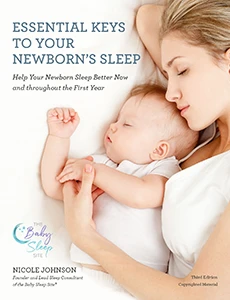
Babies are born with a range of reflexes, all of them important to their development. The Moro reflex, or startle reflex, is simply another normal baby reflex. It is an important indication that your baby is developing well.
What is the Moro reflex (aka Startle reflex)?
The Moro reflex is sometimes referred to as the startle reflex. It is a perfectly normal newborn reflex that indicates that the baby’s nervous system is developing properly. The Moro reflex is a biological response to new or unfamiliar stimuli in an infant’s environment. When it is triggered, you may see your baby stretching their arms and legs out in front of them. The baby will then curl the arms and legs closer to their body again, as if in a slight fetal position. Your baby may gasp or cry, or they may make no noise when they do it.
Why does it happen?
The Moro reflex is an involuntary response. It is something that your baby does in response to being startled to something in their environment. Research suggests that when the Moro reflex is triggered, a baby experiences a sensation of free-falling. It is this jolt that causes them to reach out and then retract their arms back towards their bodies. The Moro reflex acts as a type of alarm that is triggered when the baby receives sudden or excessive information, via their senses.
Experts have suggested that the Moro reflex has developed as a way to protect a child from danger and to prevent them from falling. They believe that it is part of a primitive survival instinct to alert the baby to their loss of balance and to help hold on, or cling, to their mother.
Triggers
The Moro reflex is triggered when a baby experiences a sudden change in sensual stimulation. There are many such triggers, but some of the most common ones are:
- Loud or unexpected noises.
- A change in altitude or an event that alters the baby’s balance – for example, when a baby is placed into a crib or placed into or taken out of the bath.
- Sudden or abrupt changes in intensity of light.
- A sudden or unexpected touch.
- A change from one surface to another.
How long does it last?
The Moro reflex is most prominent in newborns. For most infants, it gradually gets better and usually disappears by around 4 to 6 months. The improvement of the Moro reflex will be most noticeable as your baby becomes stronger. Usually, by around 6 weeks the neck muscles on your baby’s neck will be stronger and more developed. This means that they will have a better overall balance and will be starting to improve and develop the ability to support themselves. At this stage, the Moro reflex will start to improve too.
How to Help
The world outside of the womb can be overwhelming and startling. Luckily there are things you can do to reassure your baby and to help minimize the chances of the Moro reflex disrupting your baby’s (and your) sleep.
- Hold your baby close to your body when you lay them down. Make sure your baby’s back is touching the mattress before you gently release them. This way, your baby should have enough support to prevent them from experiencing the sensation of falling.
- Swaddle your baby. Swaddling restricts your baby’s movement and helps to recreate the womb environment, which can help soothe a baby when they experience the Moro reflex. It will also help the baby to learn to self-soothe as they get older. Products like the Zipadee Zip can be great for babies who need some restriction but who need to stop being swaddled.
- Reassure your baby. Gently place your hand on their chest if they are laying down, or hold them close to your body. This touch will soothe the baby and reassure them that you are nearby.
- Daily movement. As your baby gets stronger and has greater control over their movements, they will likely demonstrate the Moro reflex less often. Make time for your baby to have the opportunity to move around and have space to stretch out their limbs.
What if there is an absence of Moro reflex?
It is healthy for your baby to exhibit the Moro reflex. The absence of the Moro reflex, on one or both sides, can be a potential sign of problems with your baby’s nervous system. A doctor will check your baby’s reflexes (including the Moro reflex) at birth. If you notice an absence of the Moro reflex, bring this to the pediatrician’s attention as soon as possible.








